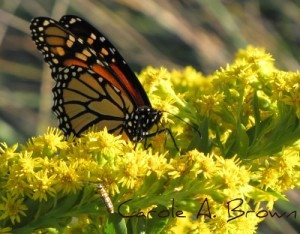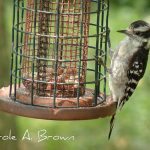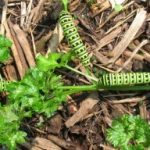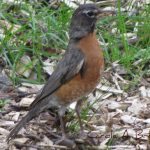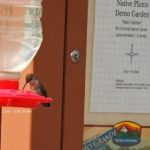Every fall an amazing phenomenon occurs as millions of Monarch butterflies make their way from across Canada and throughout the US to their wintering sites in the mountain forests of Mexico and select spots in California.
They face many perils along this journey as well as in their wintering homes. Here, they are in danger from habitat loss, pesiticides, and genetically modified crops. In Mexico logging and destruction of the forests where they spend the winter is a major concern.
And that’s where your garden comes in. Your butterfly garden can play a crucial role in ensuring their success in this long migration.
First, Monarchs need milkweed (Asclepias spp) because that’s the only plant the caterpillars can eat. Milkweed is treated like a weed in many places, and if often sprayed with Roundup and other herbicides. So when you plant lots of milkweed in your ecosystem garden, you’re already helping them out.
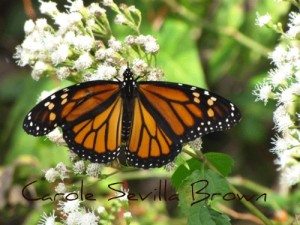
Next, you can have your garden certified as a Monarch Waystation. Your best bets for creating Monarch habitat:
- Plant Milkweed in a sunny area with well-drained soil
- Both butterflies and caterpillars need shelter from predators
- Milkweeds of differentspecies mature and flower at different times during the season. By increasing the number of milkweedspecies in your habitat you will increase the likelihood that monarchs will utilize your property for alonger period during the breeding season
- Nectar. Adult butterflies feed on nectar, so plant a wide variety of plants that bloom from spring through fall
- Don’t use pesticide
And finally, support the organizations who are working so hard to protect this endangered phenomena, both here and in Mexico.
My favorite, aside from Monarch Watch who sponsor the Monarch Waystation program, is the Monarch Monitoring Project in Cape May, NJ. They have been tagging and tracking these beautiful butterflies for many years now, and working to answer many questions:
- How many Monarchs that pass through Cape May actually make it to their wintering grounds in Michoacan Mexico in the Trans Volcanic Mountains?
- How many miles do they travel each day?
- What is the migratory pathway that they travel?
- Do all Monarch Butterflies use the same pathway?
They’ve been researching the answers to these questions since 1991, and if you’re ever in Cape May during late September and October, stop by and see their demonstration in the pavilion near the hawk watch platform at Cape May Point State Park.
More From Ecosystem Gardening:
Submit your review | |
Responding to Bethia L. Marena r. Parsley
Your caterpillars are those of a swallowtail Butterfly; They love parsley, dill, carrot, etc. They are not Monarchs, those eat only milkweeds--but any swallowtail is a thing of beauty and well worth planting more of its host plants.
I have at least a dozen monarch caterpillars in my herb garden. They are devouring my flat leaf parsley. I am thrilled, and will gladly sacrifice My herbs.
I'm wondering why you are linking to monarchwatch.org without at least giving a warning that one of their suggested nectar plants, butterfly bush, is actually considered an invasive species as written in this article http://www.ecosystemgardening.com/butterfly-bush-is-invasive-do-not-plant.html

